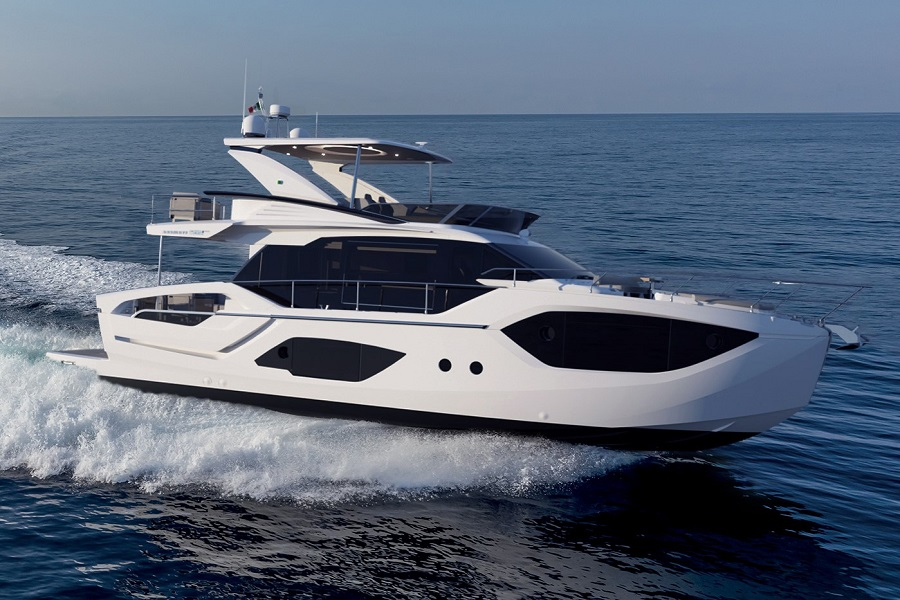 alt="Absolute signatures feature on 52 Fly"/>
alt="Absolute signatures feature on 52 Fly"/>
 alt="Multihull Special 2023: Supercats"/>
alt="Multihull Special 2023: Supercats"/>
When Sunreef celebrated its 20th anniversary at last year’s Monaco Yacht Show, famous guests included Polish statesman Lech Walesa, 2016 F1 world champion Nico Rosberg and celebrated explorer Mike Horn, an ambassador for the builder’s Explorer series of powercats and now embarking on his four-year What’s Left global expedition (click for article).
As popular as some of the attending VIPs were, the biggest cheer of the night was reserved for Sunreef’s announcement that it had secured the sale of the first 43M Eco, one of a growing selection of ‘supercat’ designs and concepts promoted by studios and shipyards around the world in recent years.
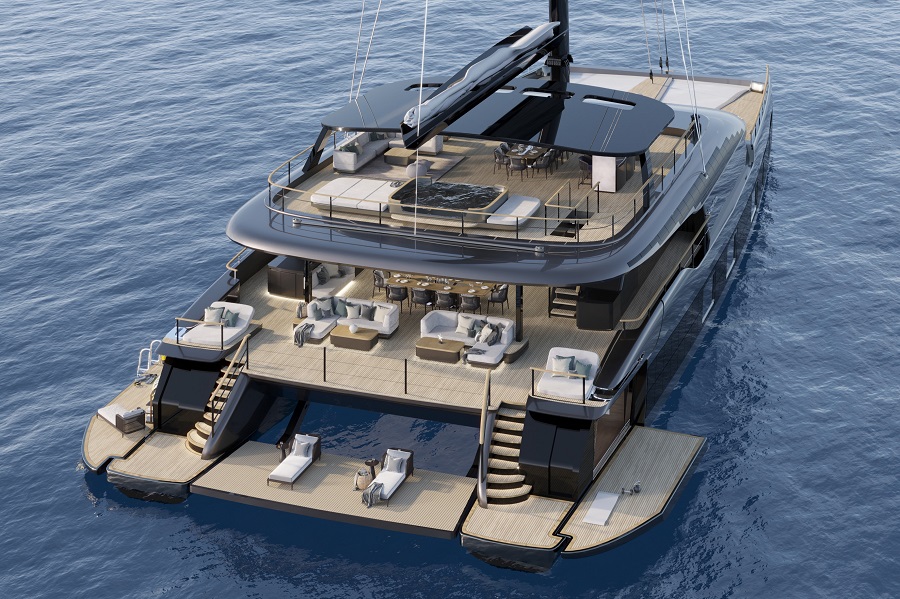
Sunreef 43M Eco
However, there was more to come from the all-action shipyard, whose dealers in Asia include Hong Seh Marine in Singapore and Lee Marine in Thailand. In January this year, Sunreef announced a second sale of the 140ft solar-powered sailing cat with a 50ft 6in beam, which it has described as the “world’s biggest electric luxury catamaran”.
As if it wasn’t busy enough running two shipyards in Gdansk and establishing another in the UAE, the shipyard confirmed the signing of the first Sunreef 100 Eco, meaning the two units of the Sunreef 80 Eco and the 80 Sunreef Power Eco already in the water will be joined by at least three much bigger sisters in the coming years.
All three of the upcoming Eco superyachts will feature the environmentally friendly, emission-free, noiseless technology that Sunreef has developed for its new Eco range of sailing and power catamarans, which now accounts for over half of the shipyard’s enquiries and orders.

Sunreef 100 Eco
Able to accommodate 12 guests, the 43M Eco can incorporate composite-integrated solar panels in its hull sides, superstructure, hard top and even mast, potentially delivering up to 60kW.
A hydrogeneration system linked to the propellers can regenerate up to 40kW while under sail or when powering along with the two 200kW electric motors, which offer a cruising speed of 11 knots and a top speed of 14. The rig includes a 49m mast supporting 1,000sqm of upwind sail area and 1,600sqm of downwind sail area.
The outdoor areas include an enormous flybridge and foredeck, and an aft cockpit overlooking the vast ‘ocean lounge’, which combines the high-low aft platform and transoms with fold-down balconies on either side. There’s also a hidden garage below the cockpit that can stow two jet-skis and other water toys.
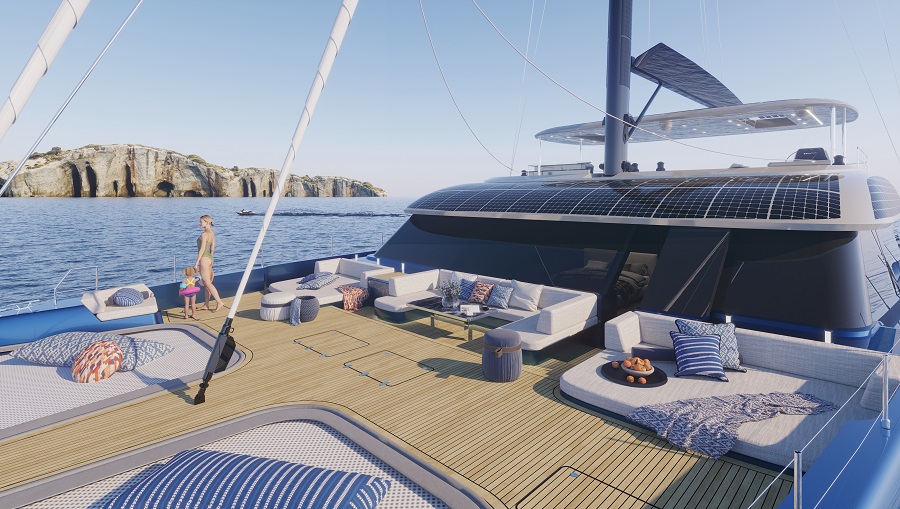
Sunreef 100 Eco
Meanwhile, the Sunreef 100 Eco has an LOA of 96ft 6in and a beam of 42ft 8in, making it a little longer and slimmer than the 100 Power (Issue 65 cover story). The 100 Eco can be fitted with twin 180kW engines and a solar-panel system delivering up to 45kW, while its design includes a three sided ocean club – like the 43M Eco – and the option of a master suite forward on the main deck.
GROWING POPULARITY
Sunreef has a strong history in superyacht catamarans, even before the late 2021 launch of its 100 Power, an imposing 94ft-long, 44ft-wide powercat that only made its public debut at this year’s Palma International Boat Show at the end of April.
Founded by Francis Lapp in 2002, Sunreef quickly proved a pioneer in the luxury catamaran sector and in 2010 launched not one but two 100ft-plus sailing catamarans – the Sunreef 102 Ipharra (31m) and the Sunreef 114 Che (35m).
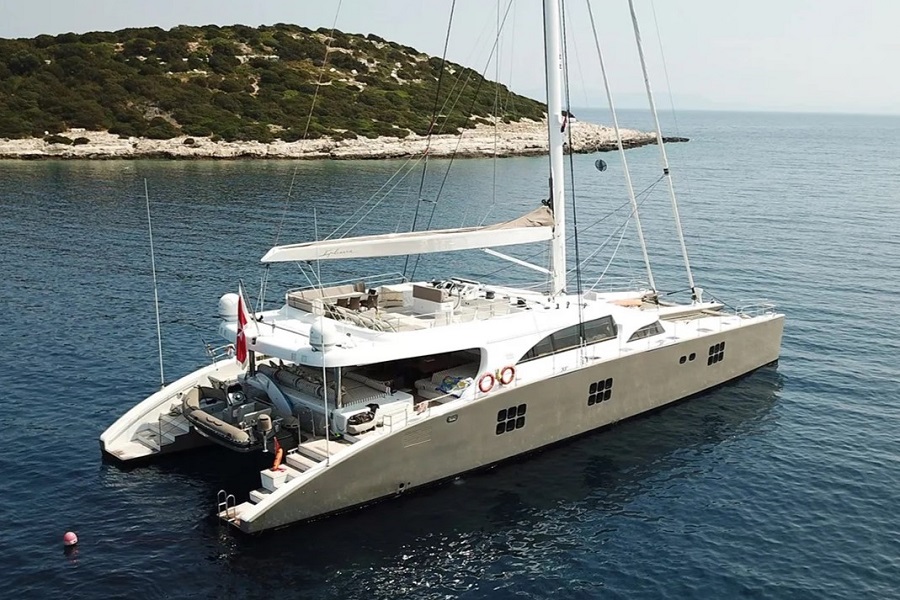
Sunreef 102 Ipharra
They were among only a handful of similar-sized sailing cats of the period, which included the 31m Hutiane (former La Sella Del Diavolo) built in Italy by Nuovo Arsenale Cartubi and the 44m VPLP designed Hemisphere built in the UK by Pendennis, launched in 2009 and 2011 respectively. The latter is the world’s largest sailing catamaran, but is set to hand over that title later this year – read on.
Over the past decade or so, Asia-Pacific has been home to multiple multihull superyacht projects including the 110ft sailing cat Ruizi (2018) built in northern China by Jinlong Mega Yacht (which also built a 46m monohull motor yacht for Jackie Chan).
On the motor yacht side, the 43m trimaran Adastra launched by McConaghy in Zhuhai in 2012 for a Hong Kong-based owner was followed six years later by a trimaran on a different scale altogether, the 84m White Rabbit built by Western Australia’s Echo Yachts for a Singaporean owner.

Royal Falcon One (41m)
In 2019, the 39m catamaran The Beast emerged from New Zealand and the 41m Royal Falcon One was launched in Sweden for a Singapore-registered company. Designed by Studio F.A. Porsche with naval architecture by Incat Crowther, Royal Falcon One has roots in Asia and is currently listed for sale with Carmen Lau of Camper & Nicholsons.
Last year, Australia-based shipyard SilverYachts launched the first Spacecat 36M from its China facility in Guangdong province. Meanwhile, HH Catamarans, an offshoot of Hudson Yacht Group, is currently completing the first HH88 sailing catamaran, its 26.8m, all-carbon flagship due to launch in Xiamen later this year.
SUMMER LAUNCHES
Another of this year’s most anticipated multihull superyachts is the 46.5m sailing cat ArtExplorer, an “aquatic museum” scheduled to launch this summer in The Italian Sea Group’s facilities in Marina di Carrara and succeed Hemisphere as the world’s longest sailing catamaran.
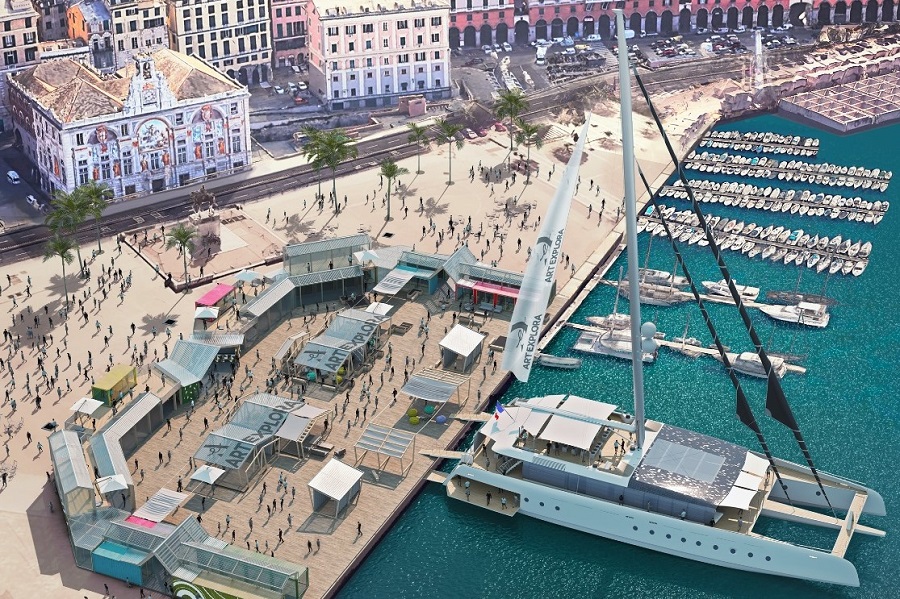
ArtExplorer (46.5m)
Perini Navi will present the yacht at the Monaco Yacht Show (September 27-30) before she departs for her first exposition in Marseille in the south of France.
French entrepreneur and philanthropist Frederic Jousset, 53, is the owner of ArtExplorer, which has been designed to be the first floating art gallery and host thousands of visitors around the world each year, although some time will be spent chartering in the Mediterranean and Caribbean.
Fraser has been leading the team in charge of the project since ArtExplorer was commissioned. Laurent Bredy, Head of Project Management at Fraser, said: “It’s a privilege to be part of such a project, with an exceptional rig, technologies specifically developed for the museum, and an iconic design.”
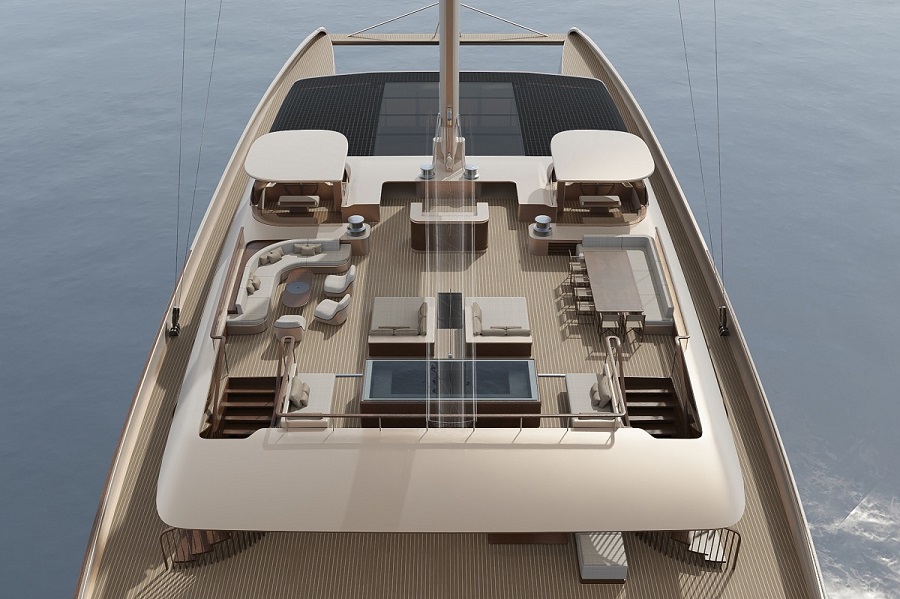
ArtExplorer (46.5m)
Also this summer, Italian shipyard Wider is scheduled to launch its first WiderCat 92 in Fano ahead of the model’s world premiere at the Cannes Yachting Festival (September 12-17).
Featuring hybrid propulsion, the 28m powercat was designed by Luca Dini with Centro Stile Wider and features a 12m (39ft 4in) beam. The wingspan extends when the side platforms drop, offering direct access to both VIP cabins and linking with the fold-down garage door to form a 720sqft, three-sided beach club.
The WiderCat 92 features 1,830sqft of solar panels, so is energy self-sufficient when anchored at sea, with unused energy stored in the lithium batteries to power systems at night.
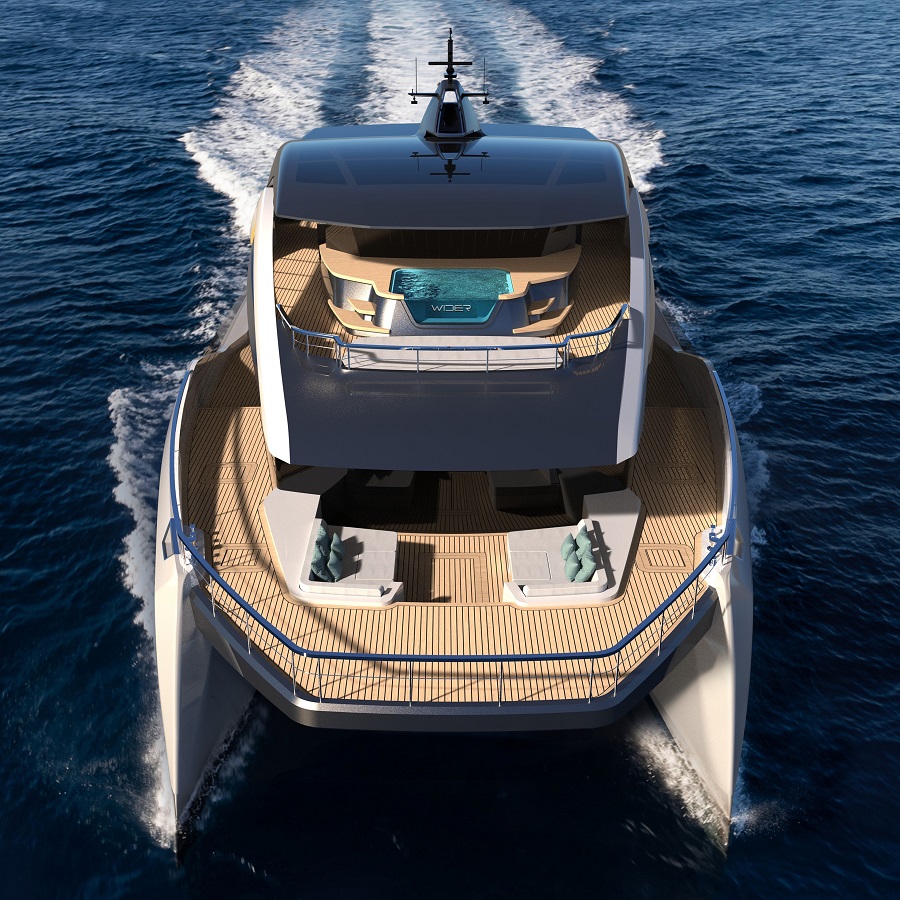
WiderCat 92 (28m)
The most recent version of the shipyard’s Serial Hybrid Propulsion System enables a cruising speed of 12 knots and a range over 1,600nm at eight knots or up to 2,400nm at six knots. In zero-emission mode, the yacht can travel 27nm at six knots in silence.
MORE TO COME
Rossinavi, which has facilities in Viareggio and Pisa, is scheduled to launch its 43m aluminium Sea Cat in spring 2024. Designed by Italy’s Fulvio de Simoni with interiors by US-based Meyer Davis, the sub-500GT hybrid-electric powercat has an LOA of 140ft and a 45ft beam, with accommodation for 10-12 guests and up to seven crew.
Attractions include a beach club with a sauna, a pool in the aft cockpit, an American bar on the large sun deck, and a large forward outdoor lounge with Jacuzzi, firepits and cinema.
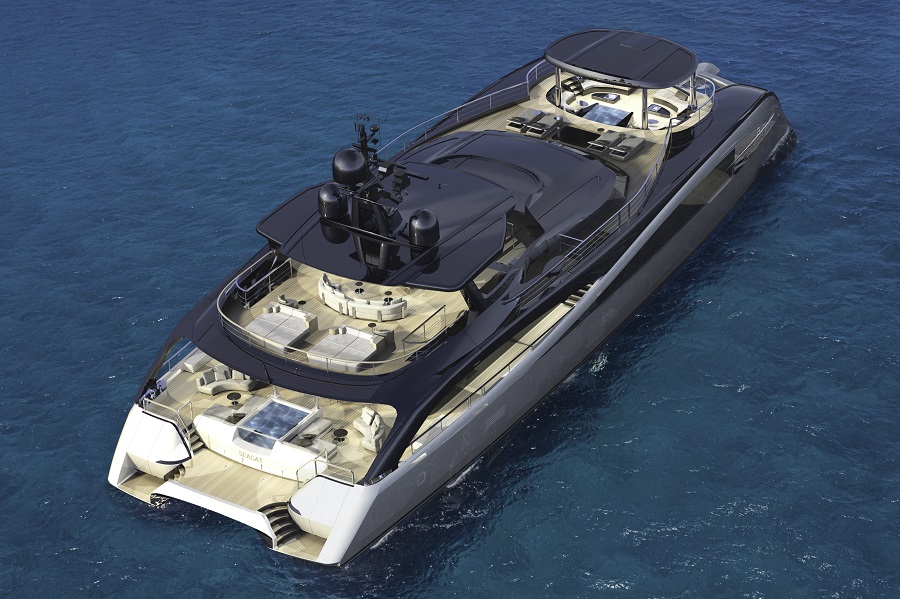
Rossinavi Sea Cat (43m)
Along with Rossinavi’s ‘Zero Noise Technology’, Sea Cat features solar panels on the top parts of the superstructure. The yacht is designed to operate in four modes including ‘one-day trip’, cruising in full electric mode, and ‘multi-day trip’, spending 90 per cent of the time in full-electric mode if passing the nights at anchor.
For a ‘transatlantic trip’, Sea Cat is estimated to spend 80 per cent of the time in full-electric mode and 20 per cent in diesel-electric mode, using diesel generators, while in ‘hibernation’, the catamaran can be self-sufficient and even donate excess energy.
Silent-Yachts, the Austrian-owned pioneer of solar-electric catamarans, is also scheduled to launch its flagship Silent 120 Explorer in 2024. Under construction at partner shipyard VisionF Yachts in Turkey, the 36.7m catamaran has a 13.85m beam, a volume of 499GT and offers extended cruising at 6-8 knots in economical mode or up to 16 knots at full power.
Featuring styling and interior design by Marco Casali, the Silent 120 incorporates a flybridge hard top covered in solar panels including two large sections that can slide outwards on each side to reveal a touch-and-go landing pad.
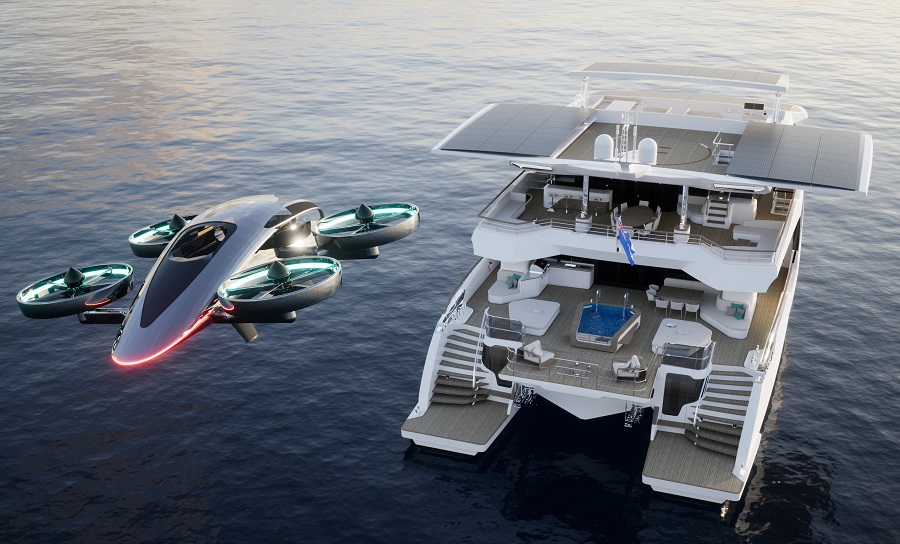
Silent 120 Explorer (37m)
Silent-Yachts, which also has its own production facility in Italy, has even announced that all-electric toys can include the XP4 ‘flying car’ by British company VRCO and the Nemo 2 two-person submersible by Dutch manufacturer U-Boat Worx.
VisionF is also moving up in size with the VisionF 100, having built multiple models of its aluminium VisionF 80 including Black, which exhibited at last year’s Monaco Yacht Show and is owned by shipyard founder Coşkun Bayraktar.
With the first hull set to be delivered in early 2025, the VisionF 100 is built of Kevlar composite for high strength-to-weight ratio and will have four Volvo Penta IPS 1050 engines for a top speed of 22 knots. The 30.5m flybridge powercat has a beam of 12m and space for up to six en-suite guest cabins, while exciting options include a 2.4m-long glass-bottomed jacuzzi on the foredeck.
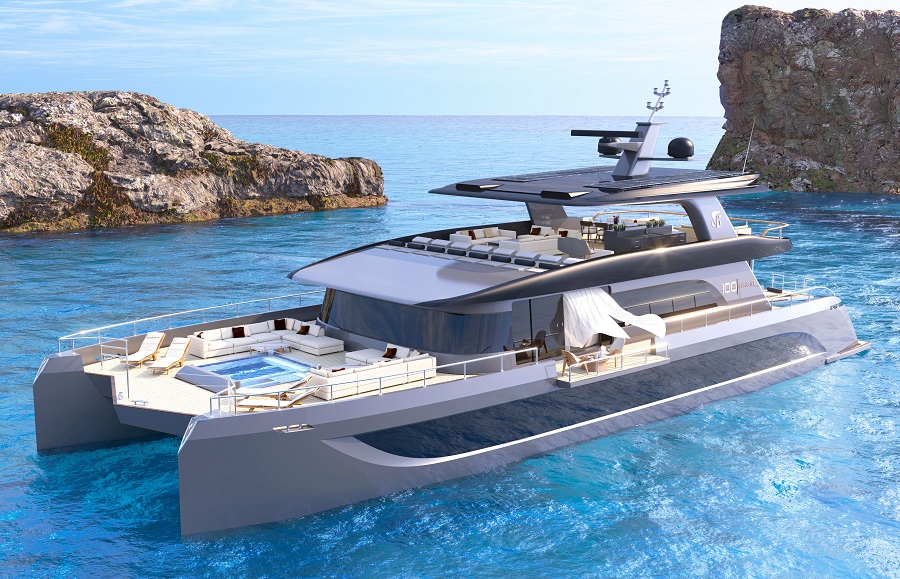
VisionF 100 (30.5m)
Meanwhile, Alva Yachts is building the Ocean Eco 90 H2, the first fuel-free 90ft catamaran with wings, which the German-owned company expects to be in the water by late 2024.
Fitted with two electric motors connected to a 500kWh-plus battery pack, the yacht features over 200sqm of solar panelling, a hydrogen fuel cell range extender and Ayro’s Oceanwings© wind-propulsion system with wind sensors on the wing sails.
There’s much more out there, in build or in design. Germany’s Ultimate Catamarans is promoting a full line of aluminium powercats with hybrid propulsion comprising the Spaceline 69, 88, 120, 150 and 150S, all designed by the Italian studio Luxury Projects headed by Laura Pomponi.
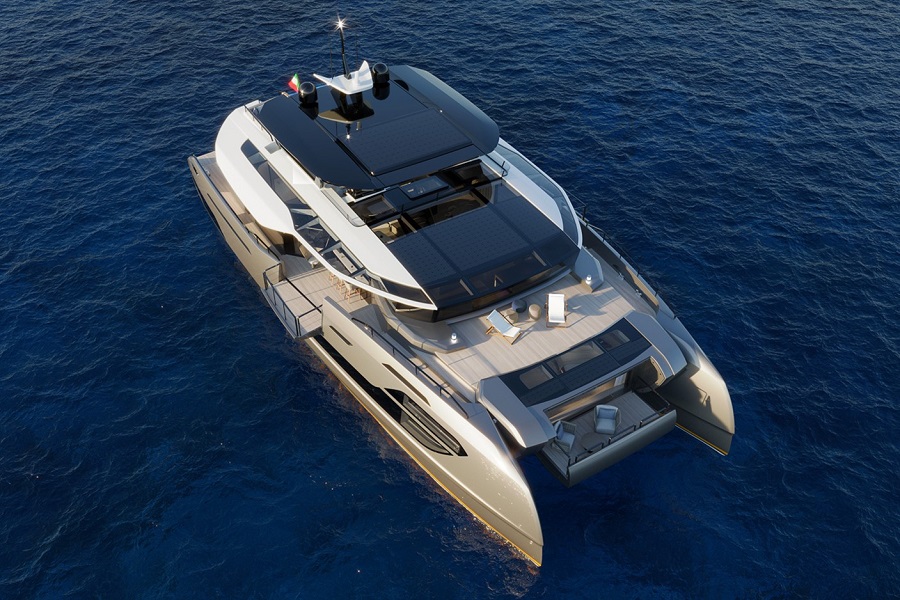
Extra X30 Villa
StellarPM, which builds in Vietnam and China, recently expanded its new-build offerings with the StellarEXP32 (105ft) and StellarEXP37 (122ft) tri-deck explorer powercats, each offered with a steel or aluminium or hull, and an extended or shorter upper deck. The company’s portfolio also includes the StellarCat series featuring the AL20-2 (67ft 6in), AL25-2 and AL25-3 tri-deck (both 82ft 5in).
Within Italy’s Palumbo Superyachts group, Extra Yachts has announced the X30 Villa powercat featuring exterior and interior by Amsterdam-based studio Phathom, while France’s Berret Racoupeau Yacht Design is behind the Zeffiro 130 and 150 powercats for sister company ISA Yachts.
Camper & Nicholsons’ listings include a 46m trimaran motor yacht design by Mani Frers for a 36 month build at McConaghy, which recently released designs for its own MC115 sailing cat (35m).
https://yachtstyle.co/yacht-style-issue-71/
Note: The original article appears in YACHT STYLE Issue 71